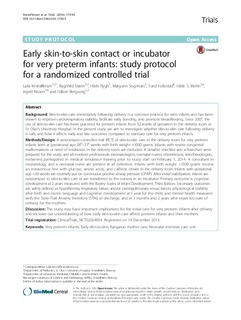| dc.contributor.author | Follestad, Turid | |
| dc.contributor.author | Sognnæs, Margunn | |
| dc.contributor.author | Støen, Ragnhild | |
| dc.contributor.author | Mohn, Hilde Stuedahl | |
| dc.contributor.author | Kristoffersen, Laila | |
| dc.contributor.author | Nissen, Ingrid | |
| dc.contributor.author | Rygh, Hilde | |
| dc.contributor.author | Bergseng, Håkon | |
| dc.date.accessioned | 2017-03-14T13:53:43Z | |
| dc.date.available | 2017-03-14T13:53:43Z | |
| dc.date.created | 2016-12-16T10:17:12Z | |
| dc.date.issued | 2016 | |
| dc.identifier.issn | 1745-6215 | |
| dc.identifier.uri | http://hdl.handle.net/11250/2434086 | |
| dc.description.abstract | Background
Skin-to-skin care immediately following delivery is a common practice for term infants and has been shown to improve cardiorespiratory stability, facilitate early bonding, and promote breastfeeding. Since 2007, the use of skin-to-skin care has been practiced for preterm infants from 32 weeks of gestation in the delivery room at St. Olav’s University Hospital. In the present study we aim to investigate whether skin-to-skin care following delivery is safe, and how it affects early and late outcomes compared to standard care for very preterm infants.
Methods/Design
A randomized controlled trial (RCT) of skin-to-skin care in the delivery room for very preterm infants born at gestational age 280–316 weeks with birth weight >1000 grams. Infants with severe congenital malformations or need of intubation in the delivery room are excluded. A detailed checklist and a flowchart were prepared for the study, and all involved professionals (neonatologists, neonatal nurses, obstetricians, anesthesiologists, midwives) participated in medical simulation training prior to study start on February 1, 2014. A consultant in neonatology and a neonatal nurse are present at all deliveries. Infants with birth weight <1500 grams receive an intravenous line with glucose, amino acids, and caffeine citrate in the delivery room. Infants with gestational age <30 weeks are routinely put on continuous positive airway pressure (CPAP). After initial stabilization, infants are randomized to skin-to-skin care or are transferred to the nursery in an incubator. Primary outcome is cognitive development at 2 years measured with the Bayley Scales of Infant Development, Third Edition. Secondary outcomes are safety defined as hypothermia, respiratory failure, and/or cardiopulmonary resuscitation, physiological stability after birth and motor, language and cognitive development at 1 year for the child, and mental health measured with the State-Trait Anxiety Inventory (STAI) at discharge, and at 3 months and 2 years after expected date of delivery for the mothers.
Discussion
The study may have important implications for the initial care for very preterm infants after delivery and increase our understanding of how early skin-to-skin care affects preterm infants and their mothers.
Trial registration
ClinicalTrials, NCT02024854. Registered on 19 December 2013. | nb_NO |
| dc.language.iso | eng | nb_NO |
| dc.publisher | BioMed Central | nb_NO |
| dc.rights.uri | https://creativecommons.org/licenses/by/4.0/ | |
| dc.subject | Very preterm infants – Early skin-to-skin – Kangaroo mother care – Neonatal intensive care unit | nb_NO |
| dc.title | Early skin-to-skin contact or incubatorfor very preterm infants: study protocol for a randomized controlled trial | nb_NO |
| dc.type | Journal article | nb_NO |
| dc.type | Peer reviewed | nb_NO |
| dc.rights.holder | © The Author(s). 2016 | nb_NO |
| dc.source.volume | 17 | nb_NO |
| dc.source.journal | Trials | nb_NO |
| dc.source.issue | 1 | nb_NO |
| dc.identifier.cristin | 1413834 | |
| dc.description.localcode | Open AccessThis article is distributed under the terms of the Creative Commons Attribution 4.0 International License (http://creativecommons.org/licenses/by/4.0/), which permits unrestricted use, distribution, and reproduction in any medium, provided you give appropriate credit to the original author(s) and the source, provide a link to the Creative Commons license, and indicate if changes were made. The Creative Commons Public Domain Dedication waiver (http://creativecommons.org/publicdomain/zero/1.0/) applies to the data made available in this article, unless otherwise stated. | nb_NO |
| cristin.unitcode | 194,65,10,0 | |
| cristin.unitcode | 194,63,15,0 | |
| cristin.unitcode | 194,65,25,0 | |
| cristin.unitname | Institutt for sirkulasjon og bildediagnostikk | |
| cristin.unitname | Institutt for matematiske fag | |
| cristin.unitname | Institutt for laboratoriemedisin, barne- og kvinnesykdommer | |
| cristin.ispublished | true | |
| cristin.fulltext | original | |
| cristin.qualitycode | 1 | |

